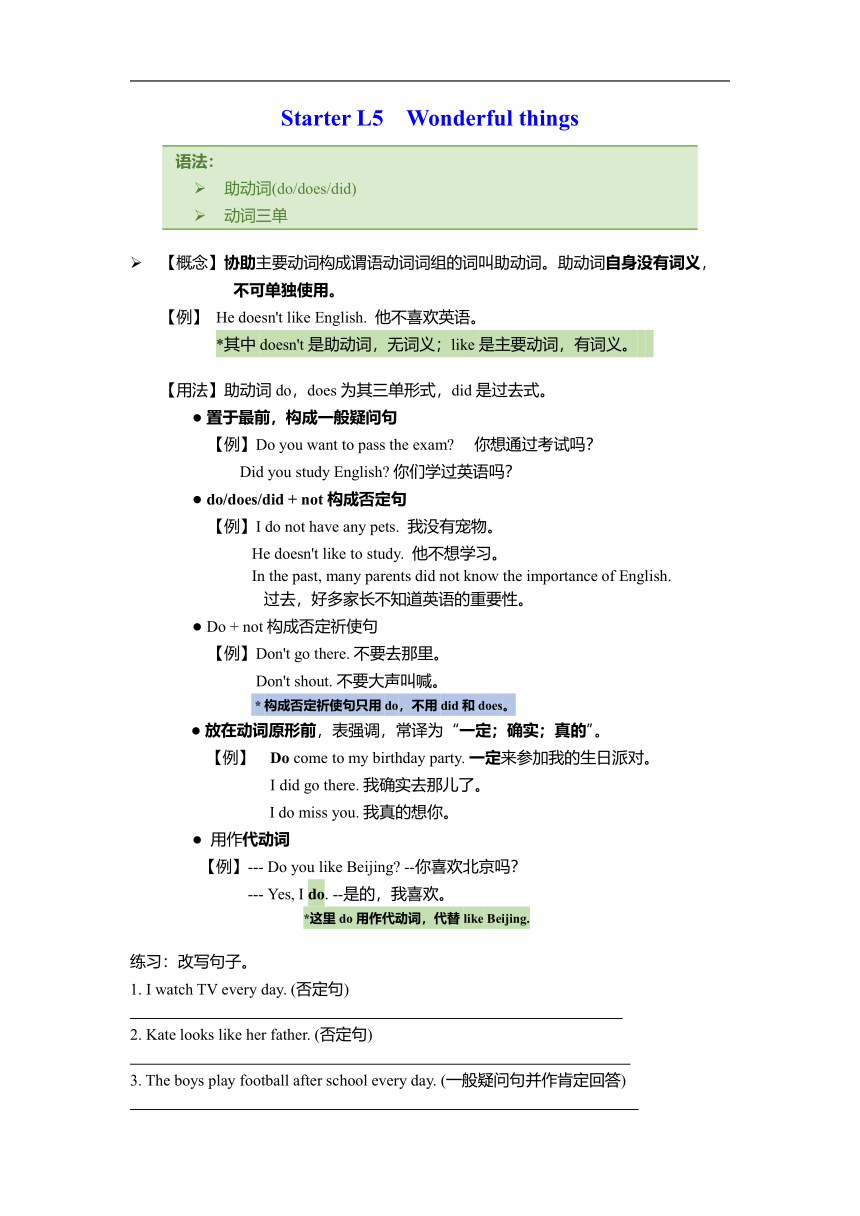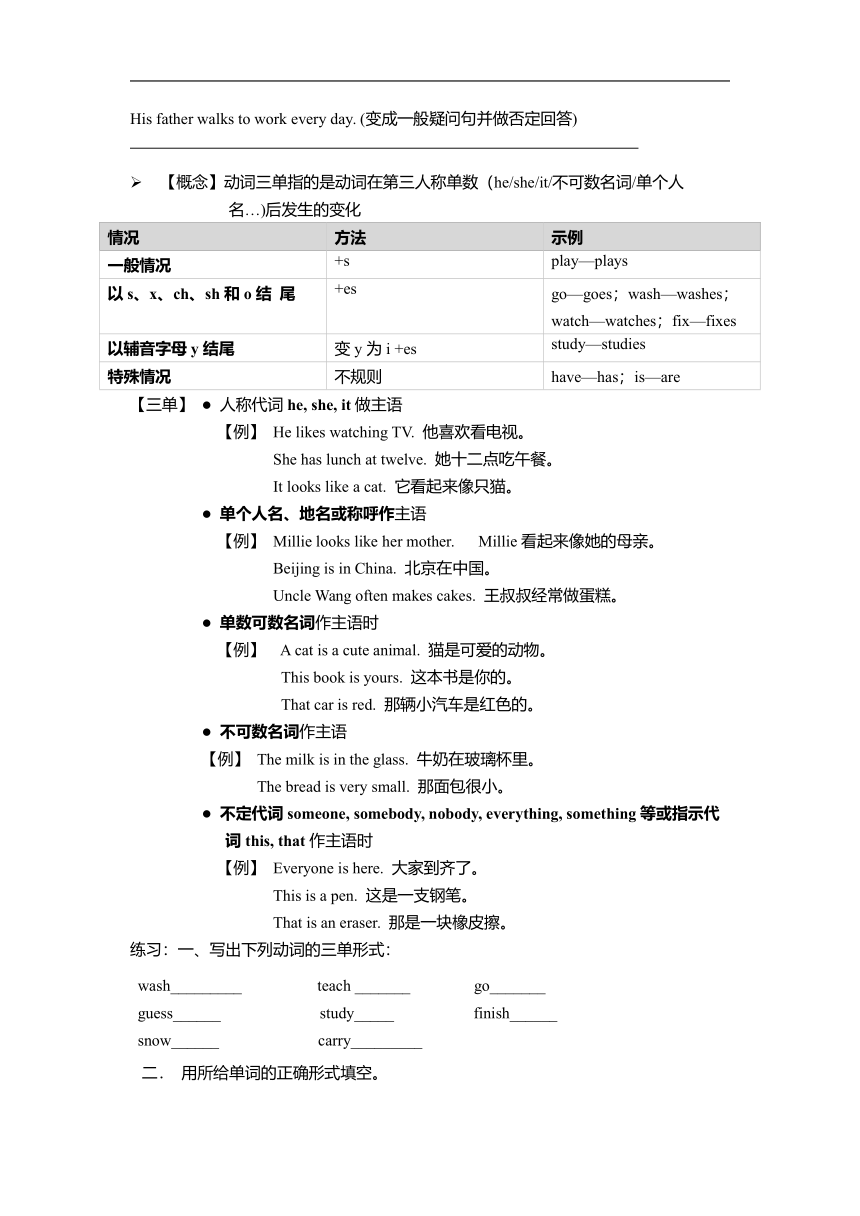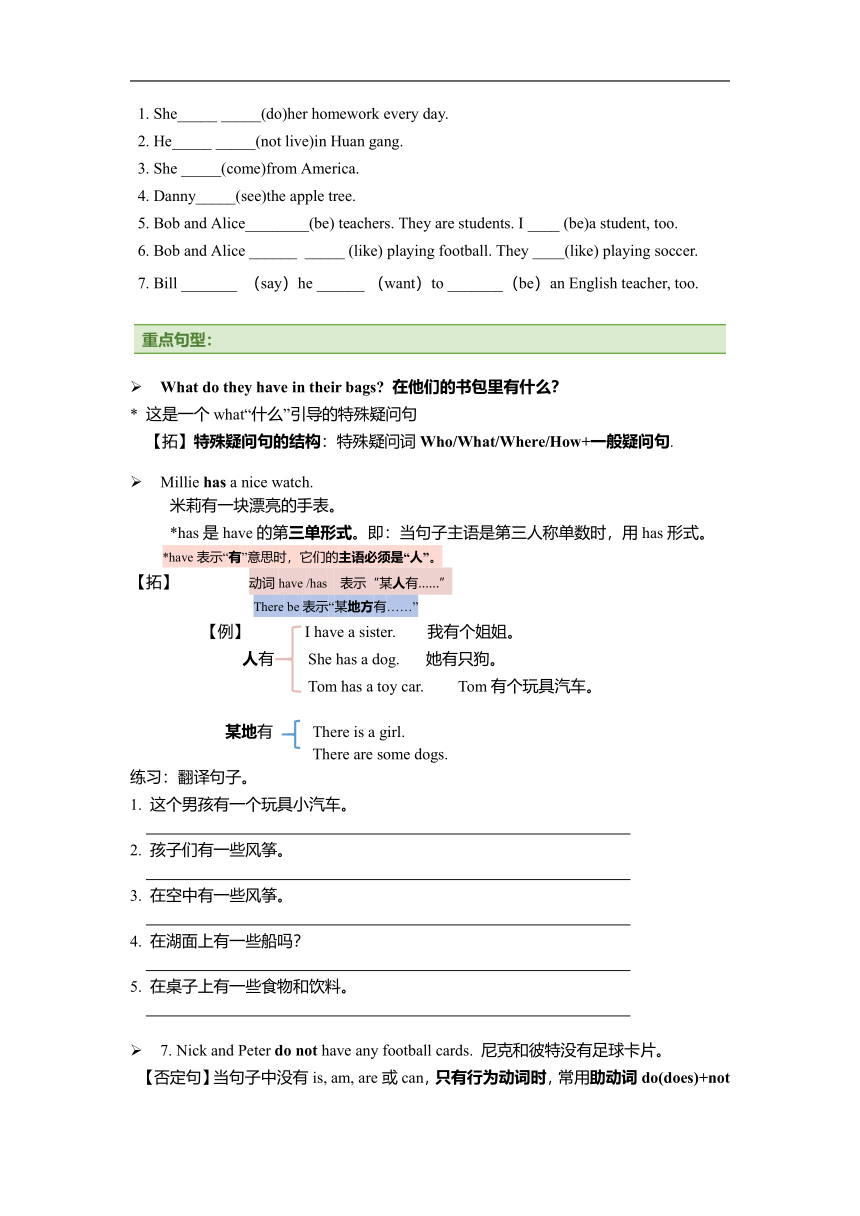牛津译林版英语预备课程 starter Lesson 5 Wonderful things 学案 (无答案)
文档属性
| 名称 | 牛津译林版英语预备课程 starter Lesson 5 Wonderful things 学案 (无答案) |  | |
| 格式 | docx | ||
| 文件大小 | 40.6KB | ||
| 资源类型 | 教案 | ||
| 版本资源 | 牛津译林版 | ||
| 科目 | 英语 | ||
| 更新时间 | 2021-09-23 09:39:14 | ||
图片预览



文档简介
Starter
L5
Wonderful
things
语法:
助动词(do/does/did)
动词三单
【概念】协助主要动词构成谓语动词词组的词叫助动词。助动词自身没有词义,
不可单独使用。
【例】
He
doesn't
like
English.
他不喜欢英语。
其中doesn't是助动词,无词义;like是主要动词,有词义。
【用法】助动词do,does为其三单形式,did是过去式。
●?置于最前,构成一般疑问句
【例】Do?you?want?to?pass?the?exam??
你想通过考试吗????
Did?you?study?English??你们学过英语吗???
●?do/does/did?+?not?构成否定句
【例】I?do?not?have
any
pets.??我没有宠物。??
?He?doesn't?like?to?study.??他不想学习。?
?
?In?the?past,?many?parents?did?not?know?the?importance?of?English.?
过去,好多家长不知道英语的重要性。?
?
●?Do
+
not构成否定祈使句
【例】Don't?go?there.?不要去那里。?
?
Don't
shout.?不要大声叫喊。
?
?构成否定祈使句只用do,不用did和does。??
●?放在动词原形前,表强调,常译为“一定;确实;真的”。【例】?
?Do?come?to?my?birthday?party.?一定来参加我的生日派对。
??
I?did?go?there.?我确实去那儿了。??
I?do?miss?you.?我真的想你。??
●
用作代动词
【例】---?Do?you?like?Beijing??--你喜欢北京吗??
?
---?Yes,?I?do.?--是的,我喜欢。
这里do用作代动词,代替like?Beijing.
练习:改写句子。
1.
I
watch
TV
every
day.
(否定句)
2.
Kate
looks
like
her
father.
(否定句)
3.
The
boys
play
football
after
school
every
day.
(一般疑问句并作肯定回答)
His
father
walks
to
work
every
day.
(变成一般疑问句并做否定回答)
?
【概念】动词三单指的是动词在第三人称单数(he/she/it/不可数名词/单个人
名…)后发生的变化
情况
方法
示例
一般情况
+s
play—plays
以s、x、ch、sh和o结
尾
+es
go—goes;wash—washes;watch—watches;fix—fixes
以辅音字母y结尾
变y为i
+es
study—studies
特殊情况
不规则
have—has;is—are
【三单】
●
人称代词he,
she,
it做主语
【例】
He
likes
watching
TV.
他喜欢看电视。
She
has
lunch
at
twelve.
她十二点吃午餐。
It
looks
like
a
cat.
它看起来像只猫。
●
单个人名、地名或称呼作主语
【例】
Millie
looks
like
her
mother.
Millie看起来像她的母亲。
Beijing
is
in
China.
北京在中国。
Uncle
Wang
often
makes
cakes.
王叔叔经常做蛋糕。
●
单数可数名词作主语时
【例】
A
cat
is
a
cute
animal.
猫是可爱的动物。
This
book
is
yours.
这本书是你的。
That
car
is
red.
那辆小汽车是红色的。
●
不可数名词作主语
【例】
The
milk
is
in
the
glass.
牛奶在玻璃杯里。
The
bread
is
very
small.
那面包很小。
●
不定代词someone,
somebody,
nobody,
everything,
something等或指示代词this,
that作主语时
【例】
Everyone
is
here.
大家到齐了。
This
is
a
pen.
这是一支钢笔。
That
is
an
eraser.
那是一块橡皮擦。
练习:一、写出下列动词的三单形式:?
wash_________?
teach?_______
go_______
guess______
?study_____
finish______
snow______?
carry_________
?二.
用所给单词的正确形式填空。
1.
She_____?_____(do)her?homework?every?day.????
2.
He_____?_____(not
live)in?Huan
gang.?
3.?She?_____(come)from?America.???????????
4.
Danny_____(see)the?apple?tree.?
5.?Bob?and?Alice________(be)?teachers.?They?are?students.?I?____?(be)a?student,?too.?
6.?Bob?and?Alice?______??_____?(like)?playing?football.?They?____(like)?playing?soccer.?
7.?Bill?_______??(say)he?______?(want)to?_______(be)an?English?teacher,?too.?
重点句型:
What
do
they
have
in
their
bags?
在他们的书包里有什么?
这是一个what“什么”引导的特殊疑问句
【拓】特殊疑问句的结构:特殊疑问词Who/What/Where/How+一般疑问句.
Millie
has
a
nice
watch.
米莉有一块漂亮的手表。
has是have的第三单形式。即:当句子主语是第三人称单数时,用has形式。
have表示“有”意思时,它们的主语必须是“人”。
【拓】
动词have
/has
表示“某人有……”
There
be表示“某地方有……”
【例】
I
have
a
sister.
我有个姐姐。
人有
She
has
a
dog.
她有只狗。
Tom
has
a
toy
car.
Tom有个玩具汽车。
某地有
There
is
a
girl.
There
are
some
dogs.
练习:翻译句子。
1.
这个男孩有一个玩具小汽车。
2.
孩子们有一些风筝。
3.
在空中有一些风筝。
4.
在湖面上有一些船吗?
5.
在桌子上有一些食物和饮料。
7.
Nick
and
Peter
do
not
have
any
football
cards.
尼克和彼特没有足球卡片。
【否定句】当句子中没有is,
am,
are或can,只有行为动词时,常用助动词do(does)+not帮助句子构成否定句。
【例】They
come
from
Japan.
→They
don’t
come
from
Japan.
他们不是来自日本。
Kate
likes
swimming.
→Kate
doesn’t
like
swimming.
凯特不喜欢游泳。
询问时间:What
time
is
it?
=
What’s
the
time?
现在什么时间了?
【回答】
It’s
+
时间。
【例】---
What
time
is
it
now?
现在几点?
---
It
is
four
o’clock.
四点。
【拓】●
询问星期几:
What
day
is
it
today?
【答】It’s
+
星期几。
【例】---
What
day
is
it
today?
---
It
is
Sunday
today.
询问日期:
What
date
is
today?
=
What’s
the
date
today?
【答】It’s
+
日期。
【例】---
What
date
is
today?
---
It’s
October
twenty
third.
It’s
raining.
天正在下雨。
这是一个“现在进行时”句子,表示动词表达的动作“rain”正在进行。
【拓】现在进行时的谓语结构为:be
+
doing
【例】The
girls
are
flying
kites
in
the
park.
女孩子们正在公园放风筝。
Look!
Kate
is
singing.
看!凯特正在唱歌。
常有Look/Listen这类暗示词
—What’s
your
favourite
thing
at
home?在家里,你最喜欢的东西是什么?
—My
favourite
thing
is
a
toy
car.
我最喜欢的东西是一辆玩具小汽车。
重点单词短语:
bring
their
schoolbags
to
school
带着书包来到学校
bring
[v.]
带来
(把东西从远处带到近处)
bring…to…
把---带到---地方
【例】Next
time,
bring
your
child
to
my
home.
下次来,把你的孩子带到我家来。
Don’t
forget
to
bring
your
homework
here!
不要忘了把家庭作业带来!
副词here,
there,
home前不能用介词to
【拓】take
[v.]
把……拿走
(把某物由近处拿到远去)
take
away
拿走
【例】It’s
time
for
supper.
Take
your
books
away.
该吃晚饭了。把书收走。
It
will
rain,
please
take
an
umbrella
with
you.
天要下雨,请带一把雨伞。
.
all
of
the
students
所有的学生
all
of
+the+复数名词,所有的…
【例】All
of
the
books
are
new.
所有的书都是新的。
All
of
the
teachers
come
here.
所有的老师都来了。
Lily
likes
drawing.
莉莉喜欢画画。
like
doing喜欢做…
强调“习惯性喜欢做什么”,已形成一种爱好。
【例】My
grandpa
likes
reading
newspaper.
我爷爷喜欢看报。(看报纸是我爷爷多年养成的习惯)
Some
schoolbags
are
not
light.
They
are
heavy!
一些书包不轻。他们很重!
light
[adj.]
轻的
?
heavy
[adj.]
重的
【例】The
bike
is
light,
but
the
bus
is
heavy.
自行车轻但公交车重。
It
tells
the
right
time.
它能报出准确时间。
时钟报出、显示时间,常用tell表达。
【拓】tell
stories
讲故事
;
tell
lies
说谎
;
tell
right
or
wrong
判断对错
play
football
踢足球
;
play
basketball
打篮球
play
table
tennis
打乒乓球
;
play
volleyball
打排球
动词后面接表示球类运动的名词时,这些球类运动名词前不加定冠词the!
【拓】have与“一日三餐”连用时,不用定冠词the。
【例】have
breakfast吃早餐;have
lunch吃中餐;have
supper吃晚餐。
—Do
you
have
toys.
你们有玩具吗?
—Yes,
we
do.
We
have
some
toy
cars,
toy
planes
and
toy
ships.
是的,我们有。我们有一些玩具小汽车,玩具飞机和玩具船。
名词修饰名词的词组变复数时,只把最后的名词变复数。
【例】toy
cars玩具小汽车
;
toy
ships玩具船
;
shoe
shops
鞋店
【拓】当前面的名词是表示“性别”的名词“man,
woman”时,词组变复数时,两个名词都要变成复数。
【例】a
man
teacher一位男教师
→
some
men
teachers一些男教师
练习:写出下列词组的复数形式。
an
apple
tree一颗苹果树
→
a
toy
shop一个玩具店
→
a
woman
doctor一位女医生
→
over
there
那边,指较远的地方。
【例】My
bike
is
over
there.
我的自行车在那边。
Please
put
your
bag
over
there.
请把你的书包放在那边。
Let
sb.
do
sth.
让某人做某事。
【例】Let’s
go
to
school.
让我们一起上学去。
Let’s
go
and
play
with
them.
让我们去陪他们玩。
play
with
them
和他们玩
with是介词
with
sb.
和某人一起
【例】Tom
often
plays
basketball
with
his
classmates
after
school.
汤姆经常放学后和他的同学们一起打篮球。
注意用形容词性物主代词(my/your/her/his/their/its)
my
favourite
toy我最喜欢的玩具
favourite
[adj.]
最喜爱的;最喜欢的
【例】Which
subject
do
you
like
best?=What’s
your
favourite
subject?
你最喜欢的科目是什么?
on
its
face
在它脸上
on
one’s
face
在某人的脸上
【例】It
has
small
eyes
on
her
face.
它的眼睛很小。
a
round
white
body.一个圆圆的白颜色肚子
几个形容词修饰一个名词时,顺序为:(美小圆旧黄)
1.
限定词(a/an/the,
this/that/those/that,
基数词)
2.观点描绘类形容词:beautiful美的、pretty漂亮的、lovely可爱的、nice好的
3.
大小,长短、高矮形容词:little小的、short短的
4.
形状类形容词:round圆的、narrow扁的
5.
年龄、时代形容词:old老的;旧的、new新的、young年轻的
6.
颜色形容词:yellow黄的、blue蓝的、orange橙色的
7.
国籍、地区形容词:American美国人的、Canadian加拿大的
8.材料形容词,如:plastic塑料的、metal金属的、wooden
限定描绘大长高,形状年龄和新老,颜色国籍跟材料,作用类别往后靠
【例】a
big
round
green
apple
一个又大又圆的青苹果
a
short
young
black
boy一个矮个的年轻黑男孩
It
cannot
jump
or
run,
so
it
never
feels
tired!它不能跳或跑,所以它从不感到累。
●
cannot是can
not的缩写形式,也可缩写成can’t。
●
or(或),常用于选择疑问句和否定句中。
【例】Is
it
a
monkey
or
a
panda?
它是一只猴子还是一只熊猫?
这种句型叫做选择疑问句,一般回答要二选一。:It’s
a
panda.不能用Yes
or
no
来回答
The
old
woman
can’t
speak
English
or
Japanese.
那位老奶奶既不会讲英语,也不会讲日语。
L5
Wonderful
things
语法:
助动词(do/does/did)
动词三单
【概念】协助主要动词构成谓语动词词组的词叫助动词。助动词自身没有词义,
不可单独使用。
【例】
He
doesn't
like
English.
他不喜欢英语。
其中doesn't是助动词,无词义;like是主要动词,有词义。
【用法】助动词do,does为其三单形式,did是过去式。
●?置于最前,构成一般疑问句
【例】Do?you?want?to?pass?the?exam??
你想通过考试吗????
Did?you?study?English??你们学过英语吗???
●?do/does/did?+?not?构成否定句
【例】I?do?not?have
any
pets.??我没有宠物。??
?He?doesn't?like?to?study.??他不想学习。?
?
?In?the?past,?many?parents?did?not?know?the?importance?of?English.?
过去,好多家长不知道英语的重要性。?
?
●?Do
+
not构成否定祈使句
【例】Don't?go?there.?不要去那里。?
?
Don't
shout.?不要大声叫喊。
?
?构成否定祈使句只用do,不用did和does。??
●?放在动词原形前,表强调,常译为“一定;确实;真的”。【例】?
?Do?come?to?my?birthday?party.?一定来参加我的生日派对。
??
I?did?go?there.?我确实去那儿了。??
I?do?miss?you.?我真的想你。??
●
用作代动词
【例】---?Do?you?like?Beijing??--你喜欢北京吗??
?
---?Yes,?I?do.?--是的,我喜欢。
这里do用作代动词,代替like?Beijing.
练习:改写句子。
1.
I
watch
TV
every
day.
(否定句)
2.
Kate
looks
like
her
father.
(否定句)
3.
The
boys
play
football
after
school
every
day.
(一般疑问句并作肯定回答)
His
father
walks
to
work
every
day.
(变成一般疑问句并做否定回答)
?
【概念】动词三单指的是动词在第三人称单数(he/she/it/不可数名词/单个人
名…)后发生的变化
情况
方法
示例
一般情况
+s
play—plays
以s、x、ch、sh和o结
尾
+es
go—goes;wash—washes;watch—watches;fix—fixes
以辅音字母y结尾
变y为i
+es
study—studies
特殊情况
不规则
have—has;is—are
【三单】
●
人称代词he,
she,
it做主语
【例】
He
likes
watching
TV.
他喜欢看电视。
She
has
lunch
at
twelve.
她十二点吃午餐。
It
looks
like
a
cat.
它看起来像只猫。
●
单个人名、地名或称呼作主语
【例】
Millie
looks
like
her
mother.
Millie看起来像她的母亲。
Beijing
is
in
China.
北京在中国。
Uncle
Wang
often
makes
cakes.
王叔叔经常做蛋糕。
●
单数可数名词作主语时
【例】
A
cat
is
a
cute
animal.
猫是可爱的动物。
This
book
is
yours.
这本书是你的。
That
car
is
red.
那辆小汽车是红色的。
●
不可数名词作主语
【例】
The
milk
is
in
the
glass.
牛奶在玻璃杯里。
The
bread
is
very
small.
那面包很小。
●
不定代词someone,
somebody,
nobody,
everything,
something等或指示代词this,
that作主语时
【例】
Everyone
is
here.
大家到齐了。
This
is
a
pen.
这是一支钢笔。
That
is
an
eraser.
那是一块橡皮擦。
练习:一、写出下列动词的三单形式:?
wash_________?
teach?_______
go_______
guess______
?study_____
finish______
snow______?
carry_________
?二.
用所给单词的正确形式填空。
1.
She_____?_____(do)her?homework?every?day.????
2.
He_____?_____(not
live)in?Huan
gang.?
3.?She?_____(come)from?America.???????????
4.
Danny_____(see)the?apple?tree.?
5.?Bob?and?Alice________(be)?teachers.?They?are?students.?I?____?(be)a?student,?too.?
6.?Bob?and?Alice?______??_____?(like)?playing?football.?They?____(like)?playing?soccer.?
7.?Bill?_______??(say)he?______?(want)to?_______(be)an?English?teacher,?too.?
重点句型:
What
do
they
have
in
their
bags?
在他们的书包里有什么?
这是一个what“什么”引导的特殊疑问句
【拓】特殊疑问句的结构:特殊疑问词Who/What/Where/How+一般疑问句.
Millie
has
a
nice
watch.
米莉有一块漂亮的手表。
has是have的第三单形式。即:当句子主语是第三人称单数时,用has形式。
have表示“有”意思时,它们的主语必须是“人”。
【拓】
动词have
/has
表示“某人有……”
There
be表示“某地方有……”
【例】
I
have
a
sister.
我有个姐姐。
人有
She
has
a
dog.
她有只狗。
Tom
has
a
toy
car.
Tom有个玩具汽车。
某地有
There
is
a
girl.
There
are
some
dogs.
练习:翻译句子。
1.
这个男孩有一个玩具小汽车。
2.
孩子们有一些风筝。
3.
在空中有一些风筝。
4.
在湖面上有一些船吗?
5.
在桌子上有一些食物和饮料。
7.
Nick
and
Peter
do
not
have
any
football
cards.
尼克和彼特没有足球卡片。
【否定句】当句子中没有is,
am,
are或can,只有行为动词时,常用助动词do(does)+not帮助句子构成否定句。
【例】They
come
from
Japan.
→They
don’t
come
from
Japan.
他们不是来自日本。
Kate
likes
swimming.
→Kate
doesn’t
like
swimming.
凯特不喜欢游泳。
询问时间:What
time
is
it?
=
What’s
the
time?
现在什么时间了?
【回答】
It’s
+
时间。
【例】---
What
time
is
it
now?
现在几点?
---
It
is
four
o’clock.
四点。
【拓】●
询问星期几:
What
day
is
it
today?
【答】It’s
+
星期几。
【例】---
What
day
is
it
today?
---
It
is
Sunday
today.
询问日期:
What
date
is
today?
=
What’s
the
date
today?
【答】It’s
+
日期。
【例】---
What
date
is
today?
---
It’s
October
twenty
third.
It’s
raining.
天正在下雨。
这是一个“现在进行时”句子,表示动词表达的动作“rain”正在进行。
【拓】现在进行时的谓语结构为:be
+
doing
【例】The
girls
are
flying
kites
in
the
park.
女孩子们正在公园放风筝。
Look!
Kate
is
singing.
看!凯特正在唱歌。
常有Look/Listen这类暗示词
—What’s
your
favourite
thing
at
home?在家里,你最喜欢的东西是什么?
—My
favourite
thing
is
a
toy
car.
我最喜欢的东西是一辆玩具小汽车。
重点单词短语:
bring
their
schoolbags
to
school
带着书包来到学校
bring
[v.]
带来
(把东西从远处带到近处)
bring…to…
把---带到---地方
【例】Next
time,
bring
your
child
to
my
home.
下次来,把你的孩子带到我家来。
Don’t
forget
to
bring
your
homework
here!
不要忘了把家庭作业带来!
副词here,
there,
home前不能用介词to
【拓】take
[v.]
把……拿走
(把某物由近处拿到远去)
take
away
拿走
【例】It’s
time
for
supper.
Take
your
books
away.
该吃晚饭了。把书收走。
It
will
rain,
please
take
an
umbrella
with
you.
天要下雨,请带一把雨伞。
.
all
of
the
students
所有的学生
all
of
+the+复数名词,所有的…
【例】All
of
the
books
are
new.
所有的书都是新的。
All
of
the
teachers
come
here.
所有的老师都来了。
Lily
likes
drawing.
莉莉喜欢画画。
like
doing喜欢做…
强调“习惯性喜欢做什么”,已形成一种爱好。
【例】My
grandpa
likes
reading
newspaper.
我爷爷喜欢看报。(看报纸是我爷爷多年养成的习惯)
Some
schoolbags
are
not
light.
They
are
heavy!
一些书包不轻。他们很重!
light
[adj.]
轻的
?
heavy
[adj.]
重的
【例】The
bike
is
light,
but
the
bus
is
heavy.
自行车轻但公交车重。
It
tells
the
right
time.
它能报出准确时间。
时钟报出、显示时间,常用tell表达。
【拓】tell
stories
讲故事
;
tell
lies
说谎
;
tell
right
or
wrong
判断对错
play
football
踢足球
;
play
basketball
打篮球
play
table
tennis
打乒乓球
;
play
volleyball
打排球
动词后面接表示球类运动的名词时,这些球类运动名词前不加定冠词the!
【拓】have与“一日三餐”连用时,不用定冠词the。
【例】have
breakfast吃早餐;have
lunch吃中餐;have
supper吃晚餐。
—Do
you
have
toys.
你们有玩具吗?
—Yes,
we
do.
We
have
some
toy
cars,
toy
planes
and
toy
ships.
是的,我们有。我们有一些玩具小汽车,玩具飞机和玩具船。
名词修饰名词的词组变复数时,只把最后的名词变复数。
【例】toy
cars玩具小汽车
;
toy
ships玩具船
;
shoe
shops
鞋店
【拓】当前面的名词是表示“性别”的名词“man,
woman”时,词组变复数时,两个名词都要变成复数。
【例】a
man
teacher一位男教师
→
some
men
teachers一些男教师
练习:写出下列词组的复数形式。
an
apple
tree一颗苹果树
→
a
toy
shop一个玩具店
→
a
woman
doctor一位女医生
→
over
there
那边,指较远的地方。
【例】My
bike
is
over
there.
我的自行车在那边。
Please
put
your
bag
over
there.
请把你的书包放在那边。
Let
sb.
do
sth.
让某人做某事。
【例】Let’s
go
to
school.
让我们一起上学去。
Let’s
go
and
play
with
them.
让我们去陪他们玩。
play
with
them
和他们玩
with是介词
with
sb.
和某人一起
【例】Tom
often
plays
basketball
with
his
classmates
after
school.
汤姆经常放学后和他的同学们一起打篮球。
注意用形容词性物主代词(my/your/her/his/their/its)
my
favourite
toy我最喜欢的玩具
favourite
[adj.]
最喜爱的;最喜欢的
【例】Which
subject
do
you
like
best?=What’s
your
favourite
subject?
你最喜欢的科目是什么?
on
its
face
在它脸上
on
one’s
face
在某人的脸上
【例】It
has
small
eyes
on
her
face.
它的眼睛很小。
a
round
white
body.一个圆圆的白颜色肚子
几个形容词修饰一个名词时,顺序为:(美小圆旧黄)
1.
限定词(a/an/the,
this/that/those/that,
基数词)
2.观点描绘类形容词:beautiful美的、pretty漂亮的、lovely可爱的、nice好的
3.
大小,长短、高矮形容词:little小的、short短的
4.
形状类形容词:round圆的、narrow扁的
5.
年龄、时代形容词:old老的;旧的、new新的、young年轻的
6.
颜色形容词:yellow黄的、blue蓝的、orange橙色的
7.
国籍、地区形容词:American美国人的、Canadian加拿大的
8.材料形容词,如:plastic塑料的、metal金属的、wooden
限定描绘大长高,形状年龄和新老,颜色国籍跟材料,作用类别往后靠
【例】a
big
round
green
apple
一个又大又圆的青苹果
a
short
young
black
boy一个矮个的年轻黑男孩
It
cannot
jump
or
run,
so
it
never
feels
tired!它不能跳或跑,所以它从不感到累。
●
cannot是can
not的缩写形式,也可缩写成can’t。
●
or(或),常用于选择疑问句和否定句中。
【例】Is
it
a
monkey
or
a
panda?
它是一只猴子还是一只熊猫?
这种句型叫做选择疑问句,一般回答要二选一。:It’s
a
panda.不能用Yes
or
no
来回答
The
old
woman
can’t
speak
English
or
Japanese.
那位老奶奶既不会讲英语,也不会讲日语。
同课章节目录
- 预备课程
- Lesson 1 Nice to meet you !
- Lesson 2 A happy family
- Lesson 3 A nice school
- Lesson 4 You look cool !
- Lesson 5 Wonderful things
- Lesson 6 Have nice food
- Lesson 7 Enjoy our days
- Lesson 8 Let's have fun !
- Unit 1 This is me
- Unit 2 Let's play sports
- Unit 3 Welcome to our school
- Unit 4 My day
- Unit 5 Let’s celebrate
- Unit 6 Food and lifestyle
- Unit 7 Shopping
- Unit 8 Fashion
